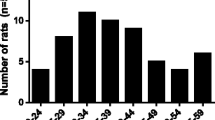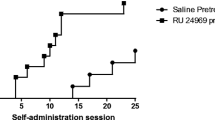Abstract
Rationale
3,4-Methylenedioxymethamphetamine (MDMA) abuse is a substantial problem in young adults. Due to a high focus on body image in this population, two main factors that may encourage MDMA use are the appetite suppressant and locomotor stimulant effects of this drug. The nucleus accumbens (NAc) is a brain region associated with the regulation of motivated and locomotor behaviours, and recent evidence suggests that NAc 5-HT4 receptors are likely to be involved in the appetite suppressant effect of MDMA. It has not yet been shown whether 5-HT4 receptors of the NAc are involved in the locomotor stimulant effects of MDMA, which may also contribute to a reduction in food intake.
Objectives
This study aimed to investigate the effect of local antagonism of serotonin 5-HT4 receptors in the NAc in the appetite suppressant and locomotor stimulant effects of MDMA.
Methods
Male hooded Wistar rats underwent surgery for the implantation of bilateral NAc microinjection cannulae under isofluorane anesthesia. Following 5–7 days of recovery, the rats received bilateral microinjections of the 5-HT4 antagonist RS39604 into the NAc immediately prior to either saline or MDMA administration. Food intake, water intake, body weight and locomotor activity were measured.
Results
RS39604 significantly increased food intake and increased weight loss in MDMA-treated but not saline-treated rats. Measures of MDMA-induced water intake or locomotor activity were not altered by antagonist administration.
Conclusions
These results demonstrate that 5-HT4 receptors in the NAc specifically regulate the appetite suppressant effects of MDMA but not MDMA-induced water intake or locomotor activity.






Similar content being viewed by others
Abbreviations
- 5-HT:
-
Serotonin
- MDMA:
-
3,4 Methylenedioxymethamphetamine
- NAc:
-
Nucleus accumbens
- ip:
-
Intraperitoneal
References
Barnes NM, Sharp T (1999) A review of central 5-HT receptors and their function. Neuropharmacology 38:1083–152
Bilsky EJ, Hubbell CL, Delconte JD, Reid LD (1991) MDMA produces a conditioned place preference and elicits ejaculation in male rats: a modulatory role for the endogenous opiods. Pharmacol Biochem Behav 40:443–47
Blundell JE (1984) Serotonin and appetite. Neuropharmacology 23:1537–1551
Callaway CW, Wing LL, Geyer MA (1990) Serotonin release contributes to the locomotor stimulant effects of 3, 4-methylenedioxymethamphetamine in rats. J Pharmacol Exp Ther 254:456–64
Callaway CW, Johnson MP, Gold LH, Nichols DE, Geyer MA (1991) Amphetamine derivatives induce locomotor hyperactivity by acting as indirect serotonin agonists. Psychopharmacology (Berl) 104:293–301
Cance JD, Ashley OS, Penne MA (2005) Unhealthy weight control behaviors and MDMA (Ecstasy) use among adolescent females. J Adolesc Health 37:409
Clifton PG, Kennett GA (2006) Monoamine binding receptors as drug targets for the treatment of obesity. CNS Neurol Disord Drug Target 5:293–312
Compan V, Zhou M, Grailhe R, Gazzara RA, Martin R, Gingrich J, Dumuis A, Brunner D, Bockaert J, Hen R (2004) Attenuated response to stress and novelty and hypersensitivity to seizures in 5-HT4 receptor knock-out mice. J Neurosci 24:412–9
Cooper SJ, Al-Naser HA (2006) Dopaminergic control of food choice: contrasting effects of SKF 38393 and quinpirole on high-palatability food preference in the rat. Neuropharmacology 50:953–963
Curran HV, Robjant K (2006) Eating attitudes, weight concerns and beliefs about drug effects in women who use ecstasy. J Psychopharmacol 20:425–431
Degenhardt L, Roxburgh A, Dunn M, Campbell G, Bruno R, Kinner SA, George J, Quinn B, White N, Topp L (2009) The epidemiology of ecstasy use and harms in Australia. Neuropsychobiol 60:176–187
Domenech T, Beleta J, Fernandez AG, Gristwood RW, Cruz Sanchez F, Tolosa E, Palacios JM (1994) Identification and characterization of serotonin 5-HT4 receptor binding sites in human brain: comparison with other mammalian species. Mol Brain Res 21:176–180
Dourish CT, Hutson PH, Curzon G (1985) Characteristics of feeding indiced by the serotonin agonist 8-hydroxy-2-(di-n-propylamino) tetralin (8-OH-DPAT). Brain Res Bull 15:377–384
Fletcher PJ, Korth KM, Robinson SR, Baker GB (2002) Multiple 5-HT receptors are involved in the effects of acute MDMA treatment: studies on locomotor activity and responding for conditioned reinforcement. Psychopharmacology (Berl) 162:282–91
Fletcher PJ, Sinyard J, Higgins GA (2006) The effects of the 5-HT(2C) receptor antagonist SB242084 on locomotor activity induced by selective, or mixed, indirect serotonergic and dopaminergic agonists. Psychopharmacology (Berl) 187:515–25
Frith CH, Chang LW, Lattin DL, Walls RC, Hamm J, Doblin R (1987) Toxicity of methylenedioxymethamphetamine (MDMA) in the dog and rat. Fundam Appl Toxicol 9:110–119
Gold LH, Koob GF, Geyer MA (1988) Stimulant and hallucinogenic behavioral profiles of 3, 4-methylenedioxymethamphetamine and N-ethyl-3, 4-methylenedioxyamphetamine in rats. J Pharmacol Exp Ther 247:547–55
Hegde SS, Bonhaus DW, Johnson LG, Leung E, Clark RD, Eglen RM (1995) RS39604: a potent, selective and orally active 5-HT4 receptor antagonist. Br J Pharmacol 115:1087–1095
Jean A, Conductier G, Manrique C, Bouras C, Berta P, Hen R, Charnay Y, Bockaert J, Compan V (2007) Anorexia induced by activation of serotonin 5-HT4 receptors is mediated by increases in CART in the nucleus accumbens. Proc Natl Sci USA 104:16335–40
Kelly PH, Seviour PW, Iverson SD (1975) Amphetamine and apormorphine responses in the rat following 6 OHDA lesions of the nucleus accumbens septi and corpus striatum. Brain Res 94:507–522
Koob GF, Riley SJ, Smith SC, Robbins TW (1978) Effects of 6-hydroxydopamine lesions of the nucleus accumbens septi and olfactory tubercle on feeding, locomotor activity, and amphetamine anorexia in the rat. J Physiol Psychol 92:917–27
Laraway S, Snycerski S, Poling A (2003) MDMA and performance under a progressive ratio schedule of water delivery. Exp Clin Psychopharm 11:309–316
Lucas JJ, Yamamoto A, Scearce-Levie K, Sandou F, Hen R (1998) Absence of fenluramine induced anorexia and reduced c-fos induction the the hypothalamus and central amygdaloid complex of serotonin 1B knockout mice. J Neurosci 18:5537–5544
McGregor A, Baker G, Roberts DC (1996) Effect of 6-hydroxydopamine lesions of the medial prefrontal cortex on intravenous cocaine self-administration under a progressive ratio schedule of reinforcement. Pharmacol Biochem Behav 53:5–9
McMahon LR, Cunningham KA (1999) Antagonism of 5-hydroxytryptamine(4) receptors attenuates hyperactivity induced by cocaine: putative role for 5-hydroxytryptamine(4) receptors in the nucleus accumbens shell. J Pharmacol Exp Ther 291:300–7
National Health and Medical Research Council (2004) The Australian code of practice for the care and use of animals for scientific purposes. Commonwealth Department of Health and Family Services, Australian Government Publishing Service, Canberra
Parrott AC (2001) Human psychopharmacology of ecstasy (MDMA): a review of 15 years of empirical research. Hum Psychopharmacol 16:557–577
Paxinos G, Watson C (1998) The rat brain in stereotaxic coordinates, 4th edn. Academic Press, New York
Reavill C, Hatcher JP, Lewis VA, Sanger GJ, Hagan J (1998) 5-HT4 receptor antagonism does not affect motor and reward mechanisms in the rat. Eur J Pharmacol 357:115–20
Rochester JA, Kirchner JT (1999) Ecstasy (3, 4-methylenedioxymethamphetamine): history, neurochemitry and toxicology. J Am Board Fam Pract 12:137–142
Spanos LJ, Yamamoto BK (1989) Acute and subchronic effects of methylenedioxymethamphetamine [(+/-)MDMA] on locomotion and serotonin syndrome behavior in the rat. Pharmacol Biochem Behav 32:835–40
Stock SL, Goldberg E, Corbett S, Katzman DK (2002) Substance use in female adolescents with eating disorders. J Adolesc Health 31:176–82
Stratford TR, Kelley AE (1997) GABA in the nucleus accumbens shell participates in the central regulation of feeding behaviour. J Neurosci 17:4434–4440
United Nations Office on Drugs and Crime (UNDOC) (2008) World drug report (online). UNDOC, New York
Vickers SP, Clifton PG, Dourish CT, Tecott LH (1999) Reduced satiating effect of d-fenfluramine in serotonin 5HT(sub 2C) receptor mutant mice. Psychopharmacology 143:309–314
Waeber C, Sebben M, Nieoullon A, Bockaert J, Dumuis A (1994) Regional distribution and ontogeny of 5-HT4 binding sites in the rodent brain. Neuropharmacology 33:527–541
White SR, Obradovic T, Imel KM, Wheaton MJ (1996) The effects of methylenedioxymethamphetamine (MDMA, “Ecstasy”) on monoamine neurotransmission in the central nervous system. Prog Neurobiol 49:455–479
Acknowledgements
We would like to thank Mr. Wayne McTegg for his invaluable assistance in animal care and Professor Iain McGregor and the School of Psychology, University of Sydney for the use of their locomotor chambers.
Disclosure/conflict of interest
None of the authors have financial interests to disclose.
Author information
Authors and Affiliations
Corresponding author
Rights and permissions
About this article
Cite this article
Francis, H.M., Kraushaar, N.J., Hunt, L.R. et al. Serotonin 5-HT4 receptors in the nucleus accumbens are specifically involved in the appetite suppressant and not locomotor stimulant effects of MDMA (‘ecstasy’). Psychopharmacology 213, 355–363 (2011). https://doi.org/10.1007/s00213-010-1982-9
Received:
Accepted:
Published:
Issue Date:
DOI: https://doi.org/10.1007/s00213-010-1982-9




